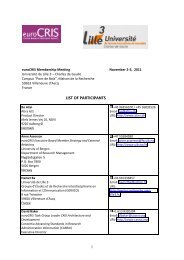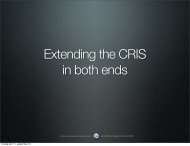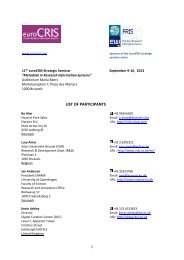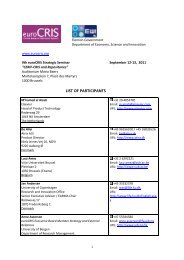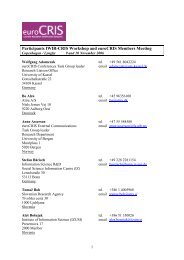Paper - EuroCRIS
Paper - EuroCRIS
Paper - EuroCRIS
You also want an ePaper? Increase the reach of your titles
YUMPU automatically turns print PDFs into web optimized ePapers that Google loves.
Berkhoff, Karin; Ebeling, Britta; Lübbe, Sven: Integrating research information into a software for higher education<br />
administration – benefits for data quality and accessibility. In: Jeffery, Keith G; Dvořák, Jan (eds.): E-Infrastructures for<br />
Research and Innovation: Linking Information Systems to Improve Scientific Knowledge Production: Proceedings of the 11th<br />
International Conference on Current Research Information Systems (June 6-9, 2012, Prague, Czech Republic). Pp. 167-176.<br />
ISBN 978-80-86742-33-5. Available from: www.eurocris.org.<br />
Information Systems (CRIS) were developed with the aim to support the handling of research<br />
information. They are explicitly designed for a consistent processing of a large amount of research<br />
data.<br />
In the following section, we give definitions for different types of Research Management Systems<br />
with the objective to place our approach of developing an integrated research management system<br />
in context.<br />
Generally, a CRIS is defined as “… any informational tool dedicated to provide access to and<br />
disseminate research information. A CRIS consists of a data model describing objects of interest<br />
to R&D and a tool or set of tools to manage the data.” 1 Its general purpose is the assistance of<br />
recording, reporting and decision-making in research projects. Compared to non-specialized software<br />
that is used for research data management, a CRIS has several advantages. It provides easy<br />
monitoring and statistical analysis of research information and output. These evaluations can<br />
support decision-making and the presentation of research. CRIS are developed according to international<br />
standards. For example, the Common European Research Information Format (CERIF 2 )<br />
was developed to ensure data exchange between different systems or institutions. Due to the<br />
standardization, metadata sets of publications or research data sets are compatible with other systems.<br />
A CERIF-compliant CRIS serves as leading system for research data management and contributes<br />
significantly to improved data accessibility, exchange and quality.<br />
Concluding from the section above, CRIS mainly focus on the evaluation and presentation of<br />
research output. In contrast, Research Management Systems (RMS), as a specific type of CRIS,<br />
additionally provide workflow support for the whole research process (Ebeling et al. 2011). From<br />
a general point of view, the research process starts with the development of a research idea and<br />
ends with the generation of research output. RMS support application procedures for third-party<br />
funds, the administration, and management of resources, and reporting. The aim of workflow<br />
support is to optimize the business processes related to research management. Further it facilitates<br />
the efficient communication between stakeholders who are involved in the research process.<br />
Workflows can be automated, e. g. when providing pre-filled reports. Within a RMS, information<br />
sets are provided according to the individual user requirements, avoiding the time-consuming<br />
search for appropriate information. The main advantage of a RMS is that it informs the researcher<br />
of the current status of all his projects. Using a RMS, the researcher can base his research management<br />
decisions on recent information with regard to resource availability, upcoming tasks or<br />
time limits.<br />
The integration of CRIS or RMS into the existing heterogeneous system environment of a university<br />
is a challenging task. This is mainly due to the fact that a number of interfaces have to be<br />
developed to allow for information exchange among the systems. There is an approach around the<br />
problem of complex interfaces: RMS can be designed as an integral part of a complete administration<br />
software for higher education administration. We call this type of RMS “Integrated Research<br />
Management System” (IRMS). An additional benefit of this approach is the consistent reuse of<br />
data within the system. Data are entered into the IRMS only once and are subsequently used within<br />
different segments of the higher education administration software. This leads to considerable<br />
advantages for data consistence and actuality, as well as for the compatibility of data. IRMS use<br />
single sign-on technology to implement a coherent role and rights concept with individual access<br />
to information.<br />
1 www.eurocris.org<br />
2 Latest release: CERIF 1.4 (http://www.eurocris.org/Index.php?page=CERIF-1.4&t=1)<br />
This work is licensed under a Creative Commons Attribution-NoDerivs 3.0 Unported License. 2



